Index Lifecycle Management (ILM)
前言
先前我們介紹過了 Index, Shard, Segment Files, Hot-Warm-Cold Architecture,知道在不同的時期要有效率的使用 Index 可以進行什麼樣的配置,接下來要介紹的是全面的 Index Lifecycle 的機制,就會使用到之前介紹的各種機制,來進行 Index 生命週期的管理。
進入此章節的先備知識
Elasticsearch Index, Shard, Segment File 的基本認識。
Index Template 的基本認識。
Rollover 與 Shrink 的機制。
Hot-Warm-Cold Architecture。
此章節的重點學習
Index Lifecycle Management (ILM) 的使用方式。
如何在 Elastic Cloud 中的 Kibana 來設定 ILM。
ILM 設定中背後的原理。
Index Lifecycle Management (ILM)
Index Lifecycle Management 顧名思意,就是用來管理 Index 的生命週期,而在 Elasticsearch Index 生命週期主要定義有四個段。
Index Lifecycle Management 主要的 4 個階段
Hot: 最新的資料,通常是用來放最新的資料。
可以寫入、可以查詢Warm: 資料進來後,不再寫入時,但還是會常常的查用,通常會放在這個階段。
不能寫入、可以查詢Cold: 資料已放蠻久的,不常使用到,但還是希望需要用到時能馬上就能用,但願意接受速度較慢一些,就會放在這個階段。
不能寫入、可以查詢(但較慢)Delete: 資源總是有限,空間也是有限,時間久了總是有些舊資料應該要從 Elasticsearch 中刪掉。

上圖可以解釋當資料隨著時間變化,會不斷產新的 Index,並且隨著時間變化 (流水號數字愈大的是愈新的,數字愈小是時間愈久),會逐漸移到下一個階段中。
在 ILM 中,你可以建立一個 Policy 來指定想要設定哪些階段、以及每個階段要進行的 Action (動作) 是什麼,而在 ILM 中可以執行的動作有以下這些。
Index Lifecycle Management 中可以用的 Action 有哪些
Rollover: 當原 index 達到 一定的大小、資料筆數、資料存放一定時間 時,自動建立新的 Index 來放新進來的資料,不會讓某 Index 一直無限的增長下去。這個動作可以針對 Index Alias 或 Data Stream 進行設定。
Shrink: 將多個 Shard 的 Index 轉成較少 Shard 數量的 Index。
Force merge: 將一個 Shard 中的 Segment Files 進行合併,可以釋放出被刪掉的文件在原先
read-only的 Segment File 所佔用的空間,也能加快查詢的速度。Freeze: 將很少使用的 Index,以盡量不使用到 heap size 的方式來存放,
Delete: 刪掉 Index。
Allocate: 指定 Index replica 的數量,以及指定 Index 可以被放在哪些 shards 的規則。(Index-level shard allocation filtering)
Set Priority: 指定 Index 的處理優先權,也就是當 node 重新啟動的時候,較高優先權的 Index 會先被 recover 而優先回到可被使用的狀態。
Unfollow: 將 Cross Cluster Replication 機制中,會 follow 的 Index 給取消 follow。在 Rollover, Shrink 處理時會自動執行這個 Action。
Wait for snapshot: 等到 Snapshot 完成後才能刪除 index。
每個階段可以進行的 Action 有哪些
Hot
Force merge, Rollover, Set priority, Unfollow
Warm
Allocate, Force merge, Read only, Set priority, Shrink, Unfollow
Cold
Allocate, Freeze, Set priority, Unfollow
Delete
Delete, Wait for snapshot
透過 Kibana 來設定 Index Lifecycle Policies
我們從 Kibana 左側選單底下的 Stack Management 進入後,可以看到以下的畫面,左邊有個 Index Lifecycle Policies 可以進入 ILM 的管理畫面。
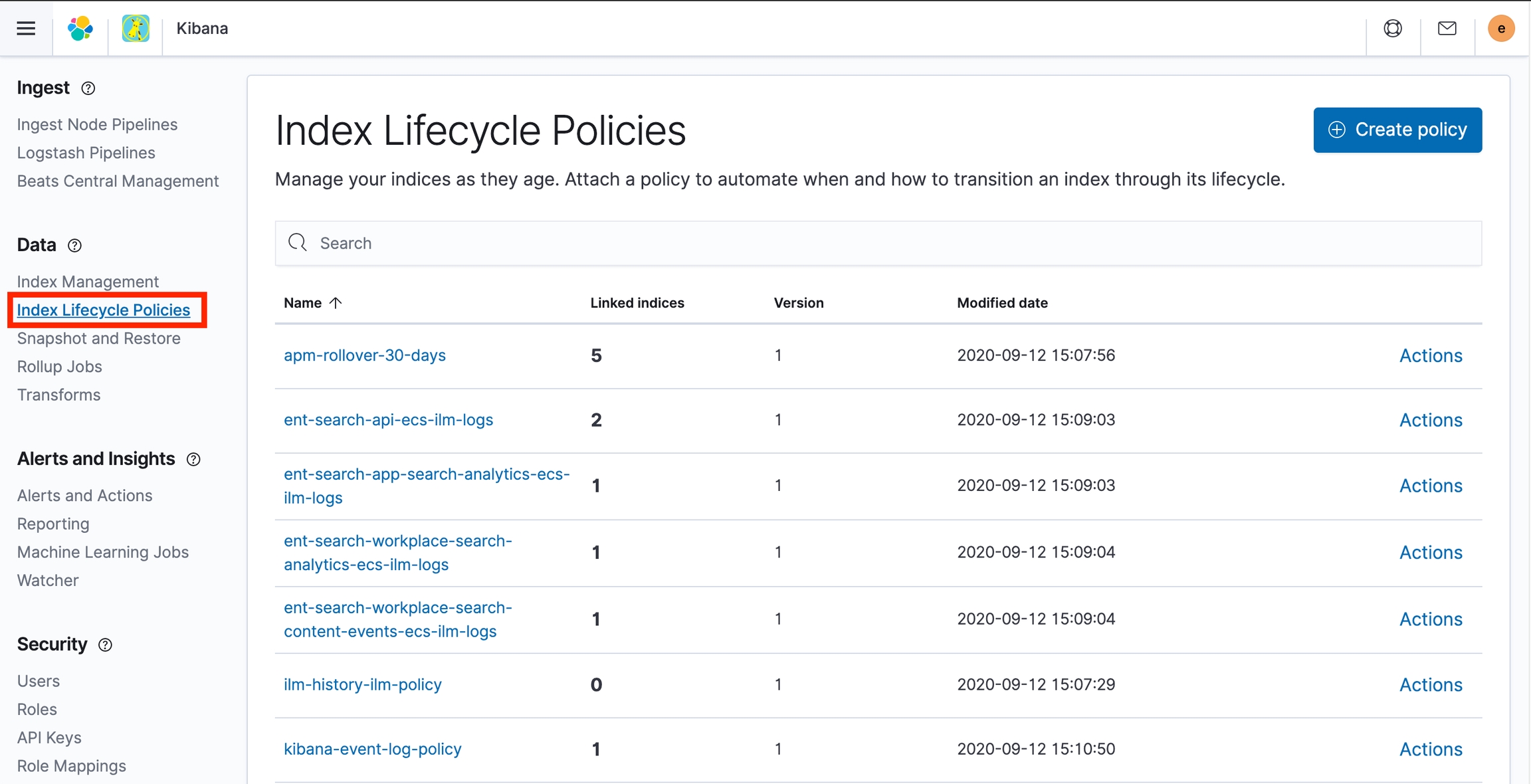
點右上的 Create Policy 即可開始建立。
Hot phase
在這個 Hot phase 的設定中,主要包含了前面介紹的一些設定 Rollover, Index Priority,不過在 Kibana 的畫可上,並沒有讓你設定 Force merge,畢竟這操作並不是適合用在一般的 Hot phase。
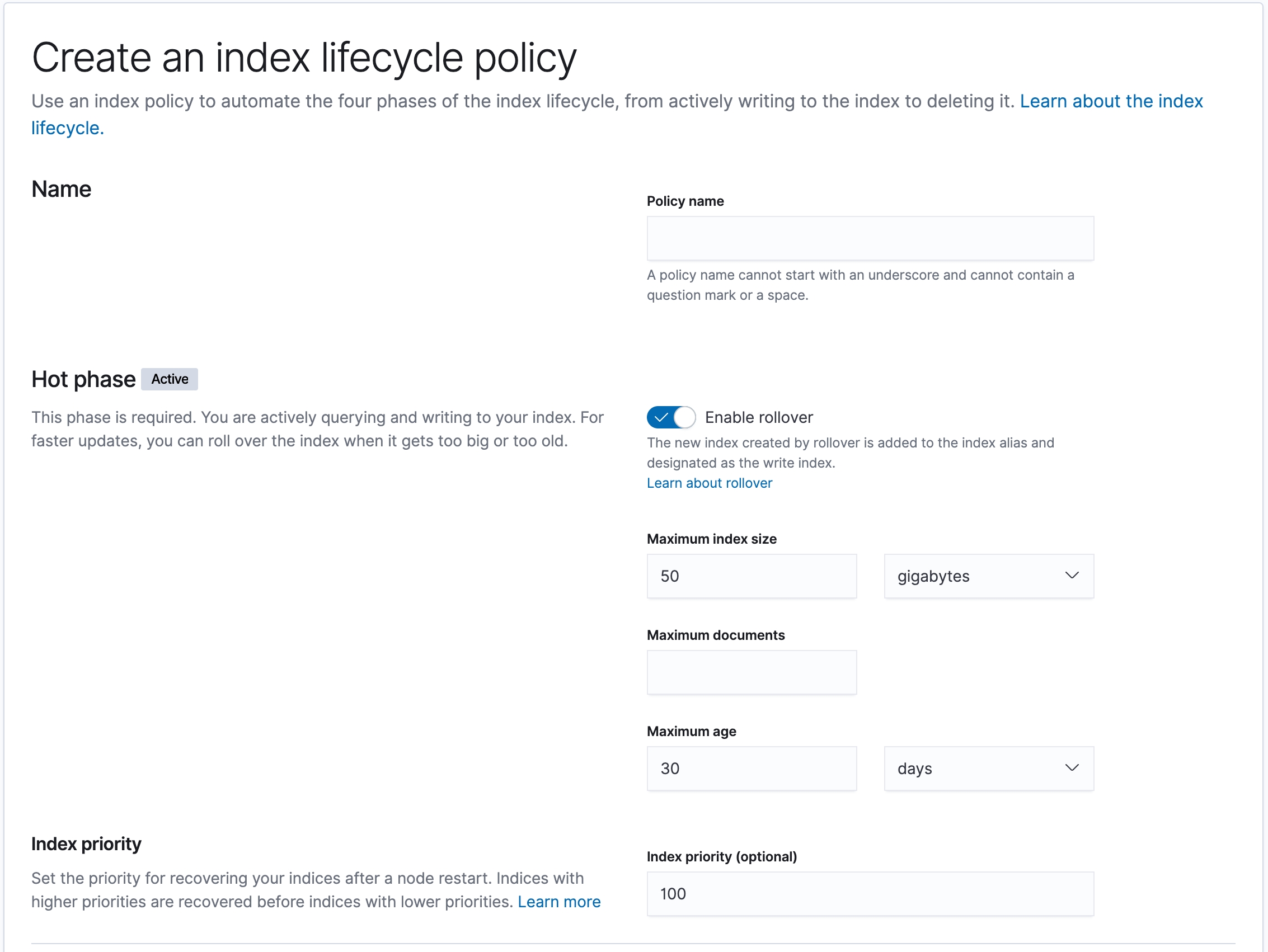
Warm Phase
在 Warm Phase 中,可以指定當 Hot Phase 中的 Index 發生 Rollover 時,是否直接把 Index 移到 Warm Phase 的階段。
若要移的話,會需要指定什麼樣的 attribute 是屬於 Warm Phase。
若使用 Elastic Cloud,他只有兩種 attribute - data:hot 和 data:warm,這也是依照硬體規格來配置過的。
除此之外可以指定 Shrink, Force merge, Index priority 等設定。

Cold Phase
在 Code Phase 的階段,也如同 Warm Phase 一樣,可以指定當 Rollover 發生多久之後 (若沒有啟動 Rollover,則是以 Index 建立的時間來判斷),要把 Index 移到 Rollover,不過因為 Elastic Cloud 目前提供的配置中,沒針對 Cold Phase 規劃的硬體配置,因此還沒辦法直接選擇,相信不久的將來會推出的。
另外可以指定是否要啟動 Freeze,以及是否要指定 Index Priority。
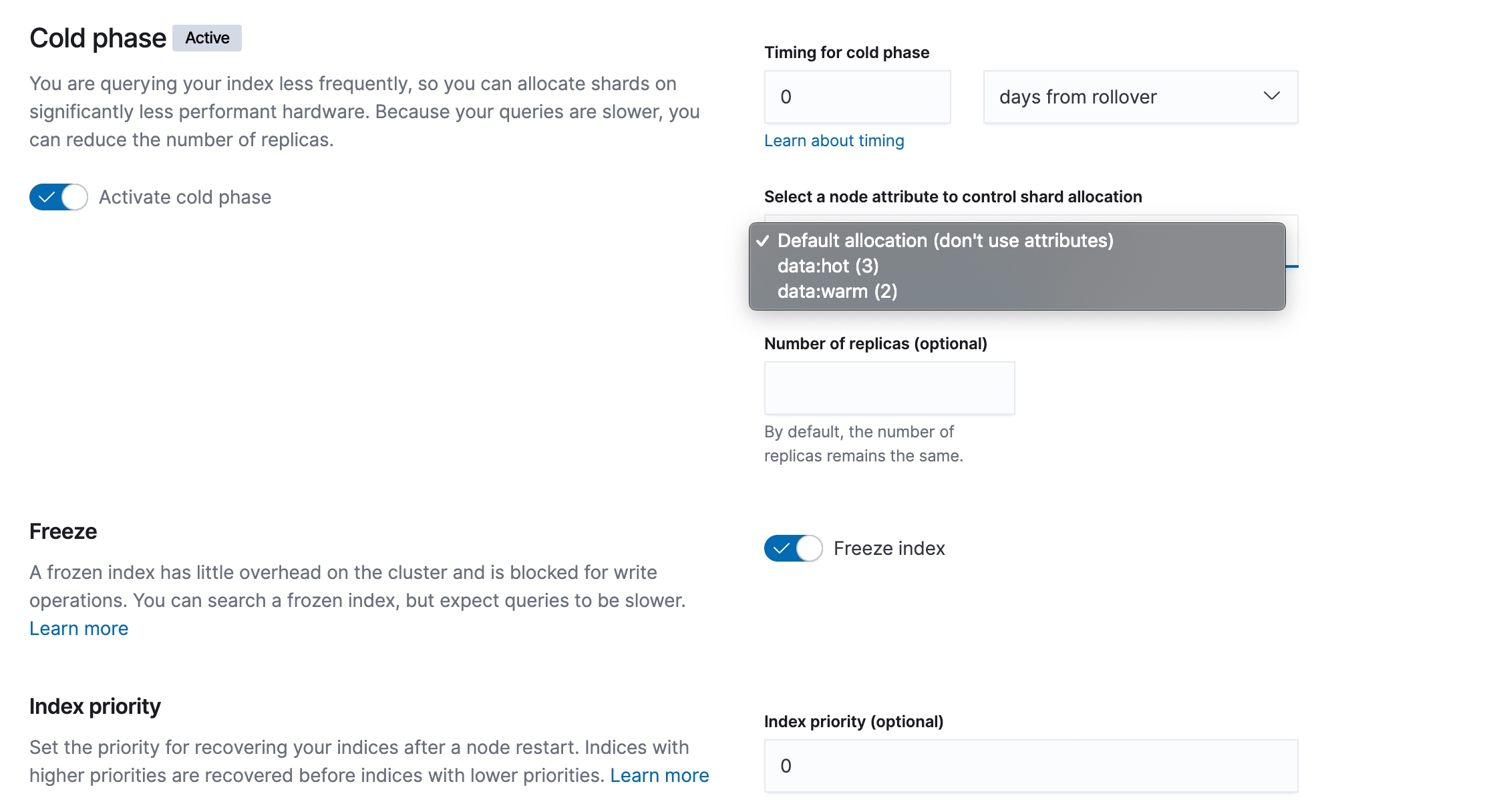
Delete Phase
Delete Phase 的設定很簡單,就是要在 index rollover 發生多久之後 (若沒有啟動 Rollover,則是以 Index 建立的時間來判斷),要刪除這個 Index。
另外可以指定,刪除之讀是否確保這個 Index 已經有備份過,這個 Snapshot Policy 會在這系列文章的面後有所介紹。

Index Lifecycle Policy 與 Index 之間的關係
當我們 Index Lifecycle Policy 設定好之後,在主畫面的 Actions 可以看到有兩個設定。
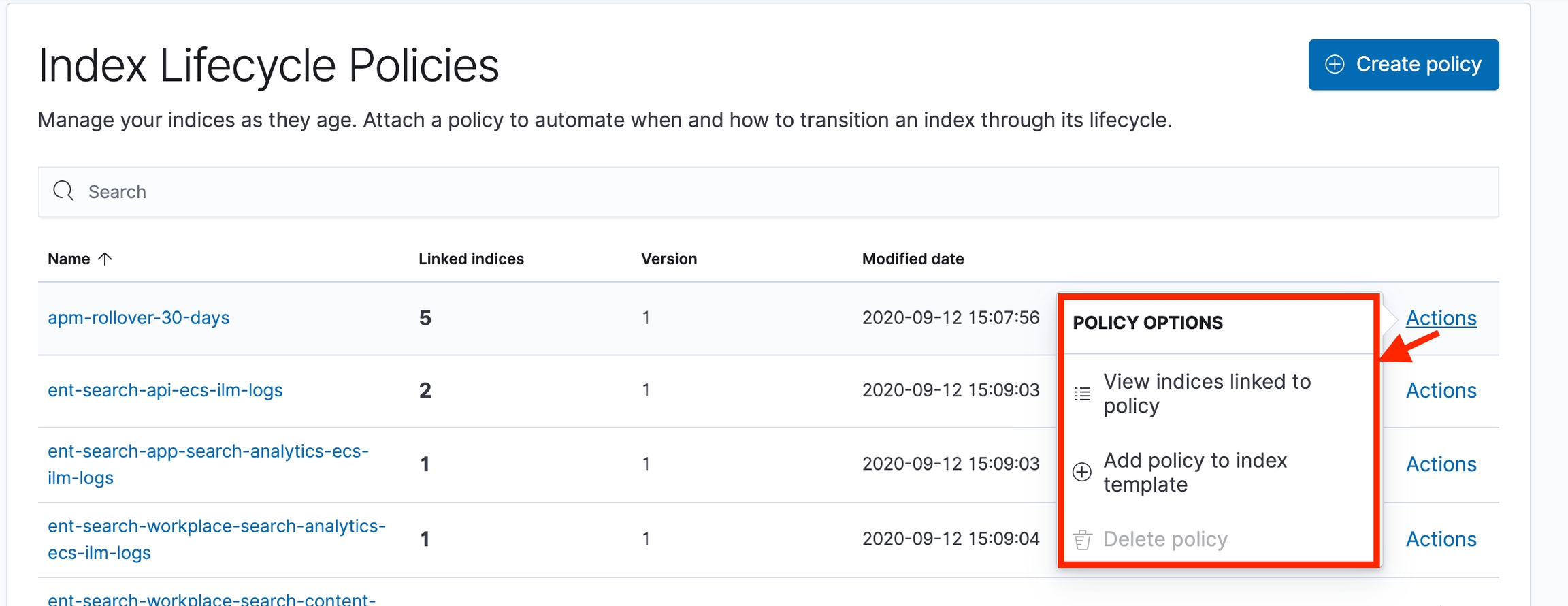
View indices linked to policy: 點下就會跳到 Index Management 的頁面,並且過濾出被這個 Indes Lifecycle Policy 所管理的 Indices 有哪些。
Add policy to index template: 這個可以指定要套用到哪個 Index Template,讓新的 Index 被建立時,自動套用這個管理機制。
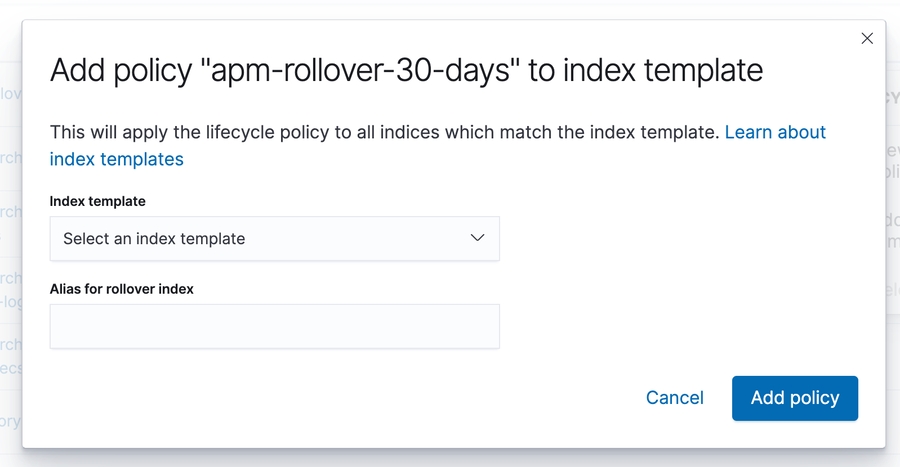
如何檢視 Index Lifecycle Policy 執行的狀況
當 Index Lifecycle Policy 建立起來之後,若想知道某個 Index, Data stream, Index Alias 所對應的 Index Lifecycle Policy 及執行的狀況、目前在哪個階段…等,可以透過 Explain lifecycle API 來查看:
以下是這個 Explain API 回傳的結構:
若是有正在執行中的步驟,也都會有詳細的資訊回傳,若有錯誤發生,也都能看得到。
建議可以上 官方文件 - Index Lifecycle Management Explain API 看更多詳細的介紹。
若有錯誤時,在排除完成後,也可以直接使用 Retry API 來進行重試。
參考資料
Last updated